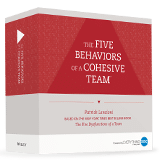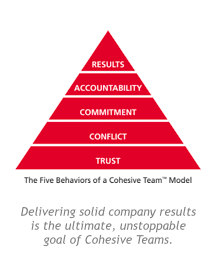
Effective teams are built on a strong foundation of Trust, the first of The Five Behaviors of a Cohesive Team™
Trust is the first building block of The Five Behaviors of a Cohesive Team. Without it, teams have difficulty managing conflicts, committing to decisions, holding each other accountable and achieving results. If your team is struggling to work together effectively, the issue of trust may be at the core of the problem.
Recently, People & Performance Strategies facilitated a Washington, D.C. Organization’s IT Team with incorporating The Five Behaviors of a Cohesive Team Assessment and findings into their individual teams. Below is an assessment of what occurred and how the team benefited; especially in terms of trust.
THE CLIENT
The IT leadership team of a Washington, D.C. organization manages more than 30 employees. Having worked with People & Performance Strategies before, the chief information officer (CIO) asked us to come out and facilitate a session after his team completed The Five Behaviors of a Cohesive Team Assessment, in conjunction with the Everything DiSC®, a behavioral style evaluation.
The Five Behaviors program was created from the best-selling book, The Five Dysfunctions of a Team by Patrick Lencioni. Lencioni and Wiley’s Workplace Learning Solutions worked together to create this assessment-based learning experience for team building. People & Performance Strategies is an authorized partner and administrator of the program.
THE PROBLEM

Although the IT leadership team is made up of smart, hard-working individuals who are experts in their field, the CIO felt that as a group, they took too long to make decisions. Or once a course of action was agreed upon in a meeting, team members were slow to carry out the directive. People were coming out of meetings agreeing in principle, but not in heart and mind. The attitude was “I’m doing this, but if you just knew what I know you would not want to do it.”
The CIO often found himself following up privately with individual team members to learn what they really thought about an issue and what reservations they had regarding a plan or decision. All of this was slowing down the team’s progress.
THE ASSESSMENT
The Everything DiSC and The Five Behaviors of a Cohesive Team evaluation uncovered a team of strong personalities – mostly Dominance and Conscientious. Those with a Dominance trait can at times be blunt. The Conscientious are often independent, but fear being wrong. The team scored low on the first Behavior – Trust.
Despite their knowledge and expertise, team members were uncomfortable sharing their ideas and opinions in meetings. They feared how their peers would view them.
THE SOLUTION
The team spent two days with us working through the Everything DiSC assessment to understand their own behavioral styles and those of their team members. They also focused on understanding The Five Behaviors, especially the foundational behavior of Trust.
“The reason we could not solve conflicts was because people were not really trusting each other,” the CIO said.
By the end of the training, the colleagues had a better sense of why people do what they do. They learned better ways to speak to each other and built a level of trust they didn’t have before.
THE RESULT
According to the CIO, his team members are now able to discuss issues openly; there is less fear and more TRUST. They hold each other accountable more and remain as committed as ever to the team and the organization.
“We’ve found a clear path to working toward solving our conflicts,” he said. Going back to the wisdom of the late Stephen Covey: “When the trust account is high, communication is easy, instant and effective.”
Without trust, a team is incapable of having healthy conflict, staying committed to its goals, holding each other accountable and focusing on achieving results. It is the basis of a cohesive, effective team.

What Can You Do To Improve Your Team’s Performance? What Are Your Roadblocks to Success?
Learn how People & Performance Strategies can help you build a solid, focused team.
